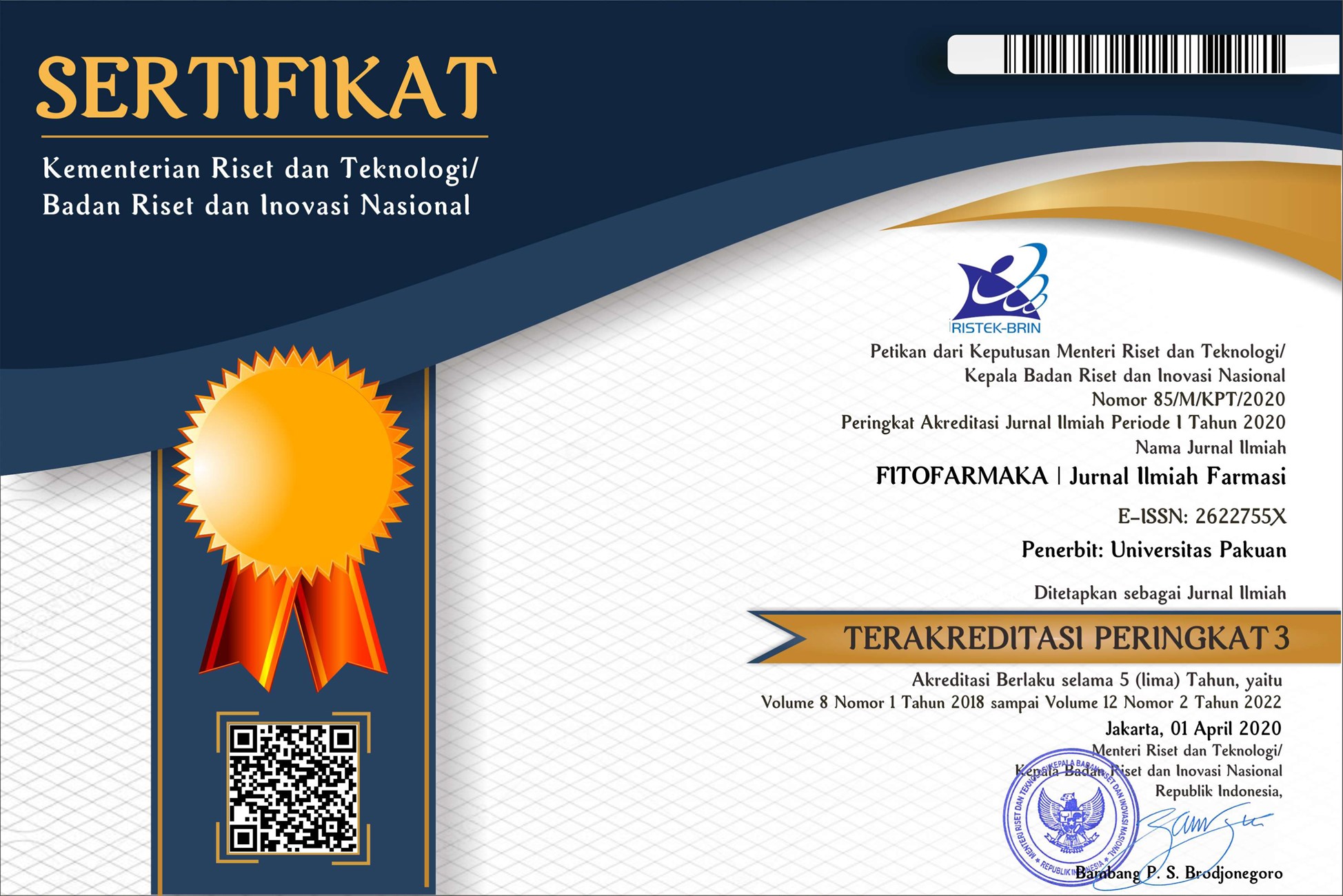Variations of Tween Surfactant and Propylene Glycol Cosurfactant in Topical Microemulsion Formulation on The Penetration of Ibuprofen
Abstract
ABSTRACT
Ibuprofen is a derivative of propionic acid, a class of non-steroidal anti-inflammatory drugs (NSAIDs). Ibuprofen has side effects on the gastrointestinal tract. So that topical use can be a solution to reduce the side effects of oral use because of the release of topical drugs through the stratum corneum which makes it selective in certain places. The preparation chosen was a topical microemulsion because it is more thermodynamically stable and has no effect on the gastrointestinal tract. This study aims to determine the effect of the ratio of surfactant concentrations of various ratios of tween 20:tween 80 and cosurfactant propylene glycol to the penetration rate of ibuprofen across the membrane and to determine the physical characteristics of topical microemulsions. Selection of tween surfactant and propylene glycol cosurfactant because it has high physical stability. This research is an experimental study, namely by making four formulations with various ratios of surfactant and cosurfactant with a difference of 2.5% in each formulation of topical ibuprofen microemulsion with a concentration of 5% ibuprofen using variations of surfactant tween 20 and tween 80, cosurfactant propylene glycol with black cumin oil phase. Evaluation of the preparation by organoleptic test, pH test of the preparation, examination of the type of emulsion, particle size measurement, microemulsion release test in vitro using the Franz diffusion method. The results show that the concentration ratio of surfactant tween 20:tween 80 and cosurfactant propylene glycol can affect particle size, pH and penetration velocity (flux) in Franz diffusion. The results of the study showed that in F1 using surfactant tween 20:tween 80 with a concentration of 71.6% (6:4) had the smallest particle size of 11.5 nm and the largest flux value was 128.45 g.cm-2.H- 1. In conclusion, variations in surfactant and cosurfactant concentrations can affect the pH of the preparation, particle size, penetration speed (flux). The results obtained that the cumulative percent and penetration speed of all formulas had significant differences (p<0.05).Keywords
References
Agustin, R., Sari, N., & Zaini, E. (2014). Pelepasan Ibuprofen dari Gel Karbomer 940 Kokristal. Jurnal Sains Farmasi & Klinis, 1(1), 7988.
Almekhlafi, S., & Thabit, A. A. M. (2014). Formulation and evaluation of lomefloxacin HCl as semisolid dosage forms. Journal of Chemical and Pharmaceutical Research, 6(3), 12421248.
Alsaad, A. A. A., Alassadi, E. A. S., Al-Salman, H. N. K., & Hussein, H. H. (2019). The Simultaneous Determination of Ibuprofen and Paracetamol in Pharmaceutical Formulations by High ‑ performance Liquid Chromatography with Ultraviolet Detection. Asian Journal Of Pharmaceutics, 13(2), 141152.
Ãlvarez, C., Núñez, I., Torrado, J. J., Gordon, J., Potthast, H., & GarcÃa-Arieta, A. (2011). Investigation on the possibility of biowaivers for ibuprofen. Journal of Pharmaceutical Sciences, 100(6), 23432349. https://doi.org/10.1002/jps.22472
Ambari, Y., Nurrosyidah, I. H., Kusumo, S. T., Rs, S., & Medika, A. (2019). Optimasi Formulasi Tablet Ibuprofen dengan Kombinasi CMC-Na & Sorbitol Sebagai Pengikat Dan Amilum Solani Sebagai Disintegran Terhadap Waktu Hancur Tablet. In Artikel Penelitian 1 | Page (Vol. 2, Issue 2).
Amin, S., Mir, S. R., Kohli, K., Ali, B., Ali, M., Amin, S., Mir, S. R., Kohli, K., Ali, B., & Ali, M. (2010). A study of the chemical composition of black cumin oil and its effect on penetration enhancement from transdermal formulations. Natural Product Research, 24(12), 11511157. https://doi.org/10.1080/14786410902940909
Anny, S. A., Rahman, M. M., Islam, F., Rahman, A., Afroz, S., Sultana, S., Raka, S. c., Azad, A. K., & Shaheen, S. M. (2012). Formulation and Development Of Ibuprofen Tablet: An In Vitro Study Bioequivalence Of New Formulation. World Journal of Pharmaceutical Research, 1(2), 207215. https://doi.org/10.20959/wjpr20203-17003
Aprilya, A., & Meirista, I. (2021). Formulasi Nanoemulsi dengan Bahan Dasar Minyak Ikan (Oleum Iecoris Aselli) Nanoemulsion Formulation with Fish Oil (Oleum Iecoris Aselli) Base Ingredients. Jurnal Sains Dan Informatika, 3(3), 370375. https://doi.org/10.22216/jsi.v4
Asija, R., Dhaker, P. C., & Nama, N. (2015). Formulation & evaluation of voriconazole ointment for topical delivery. Journal of Drug Discovery and Therapeutics, 3(26), 714. jddt.in/index.php/jddt/article/download/289/399
Bolla, P. K., Clark, B. A., Juluri, A., Cheruvu, H. S., & Renukuntla, J. (2020). Evaluation of Formulation Parameters on Permeation of Ibuprofen from Topical Formulations Using Strat-M® Membrane. Pharmaceutics, 12(2), 151. https://doi.org/10.3390/pharmaceutics12020151
Bonjardim, L. R., Cunha, E. S., Guimarães, A. G., Santana, M. F., Oliveira, M. G. B., Serafi, M. R., Araújo, A. A. S., Antoniolli, Â. R., Cavalcanti, S. C. H., Santos, M. R. V, & Quintans-júnior, L. J. (2012). Evaluation of the Anti-Infl ammatory and Antinociceptive Properties of p -Cymene in Mice. Verlag Der Zeitschrift Für Naturforschung, Tübingen · Http://Znaturforsch.Com, 1521.
Das, S., Lee, S. H., Chia, V. D., Chow, P. S., Macbeath, C., Liu, Y., & Shlieout, G. (2020). Development of microemulsion based topical ivermectin formulations: Pre-formulation and formulation studies. Colloids and Surfaces B: Biointerfaces, 189(October 2019), 110823. https://doi.org/10.1016/j.colsurfb.2020.110823
Djekic, L., Primorac, M., Filipic, S., & Agbaba, D. (2012). Investigation of surfactant/cosurfactant synergism impact on ibuprofen solubilization capacity and drug release characteristics of nonionic microemulsions. International Journal of Pharmaceutics, 433(12), 2533. https://doi.org/10.1016/j.ijpharm.2012.04.070
Hendradi, E., & Yuwono, M. (2016). Efek Perbandingan Surfaktan dan Kosurfaktan Terhadap Karakteristik dan E fi siensi Penjebakan Ovalbumin Dalam Mikroemulsi Esti Hendradi dan Mochammad Yuwono. Jurnal Farmasi Indonesia, 8(1), 310319.
Herdwiani, W. (2020). Buku Ajar Biofarmasetika & Farmakokinetika. Trans Info Media. www.transinfotim.blogspot.com
Hiroi, T., & Shibayama, M. (2017). Measurement of particle size distribution in turbid solutions by dynamic light scattering microscopy. Journal of Visualized Experiments, 2017(119), 17. https://doi.org/10.3791/54885
Irvine, J., Afrose, A., & Islam, N. (2018). Formulation and delivery strategies of ibuprofen: challenges and opportunities. Drug Development and Industrial Pharmacy, 44(2), 173183. https://doi.org/10.1080/03639045.2017.1391838
Kang, S., & Jeong, H. Y. (2014). Sorption of a nonionic surfactant Tween 80 by minerals and soils. Journal of Hazardous Materials, 284, 143150. https://doi.org/10.1016/j.jhazmat.2014.11.010
Khan, B. A., Akhtar, N., Khan, H. M. S., Waseem, K., Mahmood, T., Rasul, A., Iqbal, M., & Khan, H. (2011). Basics of pharmaceutical emulsions: A review. African Journal of Pharmacy and Pharmacology, 5(25), 27152725. https://doi.org/10.5897/AJPP11.698
Kumar, A., Saw, R. K., & Mandal, A. (2019). RSM optimization of oil-in-water microemulsion stabilized by synthesized zwitterionic surfactant and its properties evaluation for application in enhanced oil recovery. Chemical Engineering Research and Design, 147, 399411. https://doi.org/10.1016/j.cherd.2019.05.034
Lakshmi, J., Kumar, B. A., & Gupta, S. (2013). Investigation of Microemulsion as a Potential Carrier for Advanced Transdermal Delivery: An Overview. Int. J. Pharm. Sci. Rev. Res., 20(2), 5159.
Mohd Nor, N. H., Mohd Shafri, M. A., & Mohamed, F. (2014). Preparation and characterization of Nigella sativa microemulsions. International Journal of Pharmacy and Pharmaceutical Sciences, 6(9), 485489.
Mulyana, S., Fahrurroji, A., & Riza, H. (2016). Pengaruh Propilen Glikol Terhadap Penetrasi Gel Hesperidin Secara In Vitro. Naskah Publikasi, 110.
Nuraeni, W., Daruwati, I., W, E. M., & Sriyani, M. E. (2013). Prosriding Seminar Nasional Sains dan Teknologi Nuklir Verifikasi Kinerja Alat Particle size analyzer (PSA) Horiba Lb-550 Untuk Penentuan Distribusi Ukuran Nanopartikel. Prosiding Seminar Nasional Sains Dan Teknologi Nuklir, 266271.
Pamudji, J. S., Darijanto, S. T., & Rosa, S. (2012). Formulasi dan Evaluasi Mikroemulsi Minyak dalam Air Betametason 17-Valerat. Acta Pharmaceutica Indonesia, XXXVII(4), 146152.
Priani, S. E., Kurniati, T., Mulqie, L., & Mulyanti, D. (2014). Uji A Ktivitas Antibakteri Minyak Jinten Hitam (Nigella sativa Linn.) Terhadap Bakteri Propionibacterium acnes dan Formulasinya Dalam Bentuk Sediaan Mikroemulsi. Prosiding SNaPP2016 Kesehatan, pISSN 2477, 712.
Rowe, R. C., Sheskey, P. J., & Owen, S. C. (2006). Handbook of Pharmaceutical Excipients Fifth Edition.
Shalviri, r A., Sharma, A., Patel, D., & Sayani, A. (2011). Low-surfactant microemulsions for enhanced topical delivery of poorly soluble drugs. Journal of Pharmacy and Pharmaceutical Sciences, 14(3), 315324. https://doi.org/10.18433/j38p4v
Sharma, S., Bajaj, H., Bhardwaj, P., Sharma, A. D., & Singh, R. (2012). Development and characterization of self emulsifying drug delivery system of a poorly water soluble drug using natural oil. Acta Poloniae Pharmaceutica - Drug Research, 69(4), 713717.
Subagia, I. k., Januarta, I. G. A., Arisanti, C. I. S., & Samirana, P. O. (2019). Optimasi Konsentrasi Pulvis Gummi Arabicum ( PGA ) sebagai Emulgator Formulasi Emulsi Ekstrak Rimpang Kunyit ( Curcuma longa ). 8(1), 2228.
Thakker, K. D., & Chern, W. H. (2003). Development and validation of in vitro release tests for semisolid dosage forms—case study. Dissolution Technologies, 10(2), 1015. https://doi.org/10.14227/DT100203P10
Yanuar, A., Nursanti, & Anwar, E. (2010). Eksplorasi dan Karakterisasi Berbagai Kristal Ibuprofen. Majalah Ilmu Kefarmasian, VII(2), 4351.
Yati, K., Situmorang, A., & Umoro, A. (2017). Uji Difusi Mikroemulsi Nitrogliserin Menggunakan Tween 80 Sebagai Surfaktan. 11(1), 18.
DOI: 10.33751/jf.v12i2.5785
 Abstract views : 368
Abstract views : 368
Refbacks
- There are currently no refbacks.















